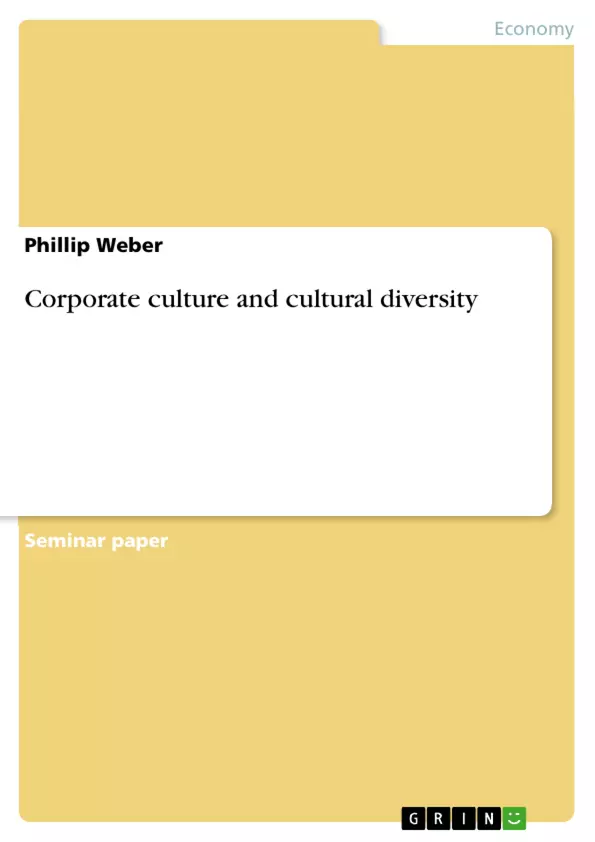International business contact and cross-border company activities are not only trends these days, but were also detectable in the past century. "The British East-India Company" or the French "Compagnie des Isles de l'Amérique" are examples for trading companies existing in the 17th century that organized exchange of goods on a worldwide scale. Today this internationalisation of organizational economic activity occurs not only sporadic, but is part of the daily work of many businesses. The reason is the proceeding economical globalization since the 60th resulting from increasing international ties between national economies and the resulting cross-border actions and bondings of companies (Blom & Meier, 2002, p. 1). The motives of the enterprises for that development are multisided.
Inhaltsverzeichnis (Table of Contents)
- International Business Contact and Cross-Border Company Activities
- Cultural Influences on International Operations of Companies
- Hofstede's Cultural Dimensions
- Power Distance Index - PDI
- Individualism and Collectivism - IDV
- Masculinity versus Femininity - MAS
- Uncertainty Avoidance Index - UAI
- Long-term-orientation - LTO
- The Importance of Strategic Alliances
- The Impact of Culture on International Cooperation
- Cultural Fit Analysis
- The Influence of Culture on Management Techniques
Zielsetzung und Themenschwerpunkte (Objectives and Key Themes)
This work explores the impact of cultural differences on international business operations, focusing on the question of whether management techniques are universally applicable or culturally influenced. It aims to provide a comprehensive understanding of the role of culture in international business, examining both theoretical perspectives and empirical research. Key themes covered include:- Cultural differences in international business
- Hofstede's cultural dimensions and their implications for management
- Strategic alliances and cross-border cooperation
- The influence of culture on management techniques and methods
- The challenges and opportunities of cultural fit analysis in international cooperation
Zusammenfassung der Kapitel (Chapter Summaries)
- International Business Contact and Cross-Border Company Activities: This chapter introduces the concept of international business and its historical development, highlighting the increasing globalization of organizational economic activity and the motivations behind it. It emphasizes the significance of understanding cultural differences in a globalized business environment.
- Cultural Influences on International Operations of Companies: This chapter examines the debate on the impact of culture on business practices. It presents two opposing views: the "culture-free-thesis" which argues for the universality of management techniques and the "Culture-bound-Thesis" which emphasizes the importance of cultural context. The chapter also introduces Hofstede's cultural dimensions as a framework for understanding cultural differences.
- Hofstede's Cultural Dimensions: This chapter provides a detailed explanation of Hofstede's five cultural dimensions: power distance, individualism, masculinity, uncertainty avoidance, and long-term orientation. It discusses the implications of each dimension for management and leadership in different cultures, highlighting the importance of understanding cultural nuances.
- The Importance of Strategic Alliances: This chapter explores the significance of strategic alliances in today's globalized economy. It examines the challenges and opportunities of cross-border cooperation, highlighting the increasing importance of international alliances for businesses.
- The Impact of Culture on International Cooperation: This chapter delves into the complexities of managing cultural differences in international collaborations. It highlights the challenges of combining different corporate cultures and governance systems, emphasizing the need for cultural sensitivity and effective communication.
- Cultural Fit Analysis: This chapter introduces the concept of cultural fit analysis as a tool for assessing the compatibility of corporate cultures in international cooperation. It examines the various methods and approaches used to benchmark and compare cultural differences, emphasizing the importance of minimizing risks before engaging in cross-border partnerships.
- The Influence of Culture on Management Techniques: This chapter delves into the ongoing debate regarding the universal applicability of management techniques. It presents contrasting perspectives on the influence of culture on management methods, acknowledging the need for further research and exploration in this area.
Schlüsselwörter (Keywords)
This work explores the complex relationship between culture and international business, focusing on topics such as cultural differences, cross-border cooperation, Hofstede's cultural dimensions, strategic alliances, cultural fit analysis, and the influence of culture on management techniques.- Arbeit zitieren
- Phillip Weber (Autor:in), 2009, Corporate culture and cultural diversity , München, GRIN Verlag, https://www.grin.com/document/147509



